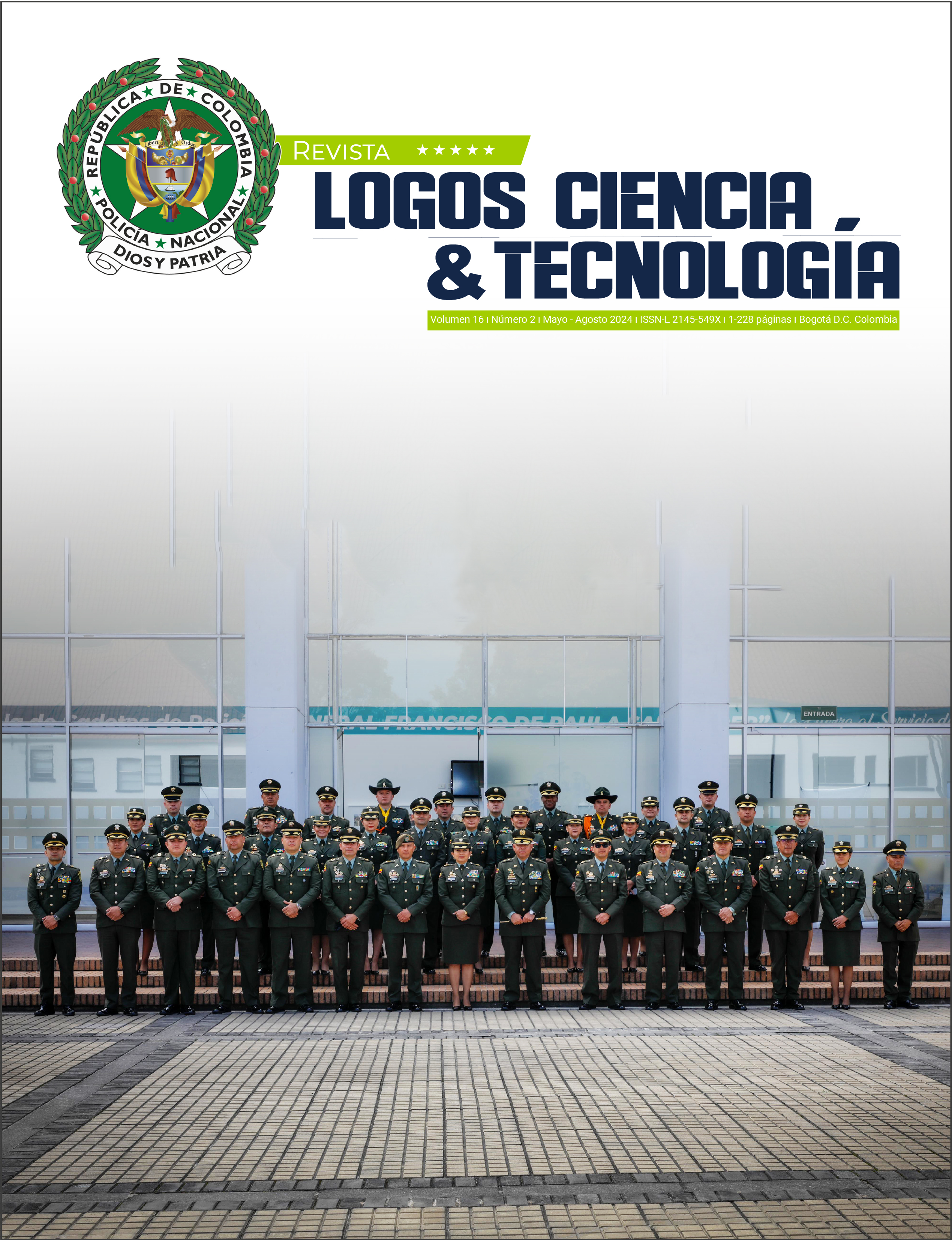Desafíos de seguridad ciudadana para el desarrollo urbano sostenible del Metro de Bogotá
DOI:
https://doi.org/10.22335/rlct.v16i2.1960Palabras clave:
desarrollo urbano, policía, seguridad ciudadana, teoría del diseño ambiental, transporte ferroviario, terrorismo.Resumen
El proyecto de la Primera Línea del Metro de Bogotá (PLMB) representa desafíos de seguridad ciudadana para los operadores de justicia y los hacedores de políticas, y garantizar la gobernanza y gobernabilidad a través de la teoría del diseño ambiental. Establecer los posibles riesgos sociales, ambientales, de seguridad humana y los fenómenos criminológicos a través de la anticipación permite evaluar las políticas en temas de seguridad y defensa (2018-2022) y el índice de paz global (IPG), así como determinar el nivel de acuerdo entre oficiales de policía según la teoría de la actividad de policía basada en evidencia. La metodología híbrida correlacional establece que se necesitan reevaluar los planes de gestión del riesgo e integrales de seguridad ciudadana, convivencia y justicia frente a los fenómenos criminológicos, como el terrorismo. El IPG indica inestabilidad, pánico político y manifestaciones violentas, como las variables que afectarán el funcionamiento. Además, fortalecer la preparación técnica de los policías, las políticas orientadas a la resolución de problemas delictivos y la criminología ambiental. Como conclusión, la probabilidad de ocurrencia de un acto terrorista es el principal riesgo, que requiere evaluar la vulnerabilidad en sitios específicos, la respuesta ante posibles interrupciones y la sinergia de las instituciones.
Descargas
Referencias
Acero, H. (2005). La seguridad ciudadana: Una responsabilidad de los gobiernos locales en Colombia. En L. Darnrnert y G. Paulsen (eds.), Ciudad y seguridad en América Latina (pp. 133-150). Facultad Latinoamericana de Ciencias Sociales.
Alpert, E. A. & Grossman, S. A. (2023). EMS Terrorism Response. En Stat Pearls. Stat Pearls Publishing. https://www.ncbi.nlm.nih.gov/books/NBK536989/
Álvarez Rubio, A. (2015). Terrorismo y contraterrorismo en Colombia. Si Somos Americanos, 15(1), 49-82. https://doi.org/10.4067/S0719-09482015000100003
Bailey, L., Harinam, V. & Ariel, B. (2020). Victims, offenders and victim-offender overlaps of knife crime: A social network analysis approach using police records. PloS One, 15(12), e0242621. https://doi.org/10.1371/journal.pone.0242621
Bendiksby, H. K. & Labib, A. (2023). Learning from disasters: The 22/7-terrorism in Norway and covid-19 through a failure modelling lens. Emergency Management Science and Technology, 3(1). https://doi.org/10.48130/EMST-2023-0007
Braga, A. A. (2006). The crime prevention value of hot spots policing. Psicothema, 18(3), 630-637. https://reunido.uniovi.es/index.php/PST/article/view/8482/8346
Braga, A. A., Weisburd, D. & Turchan, B. (2019). Focused deterrence strategies effects on crime: A systematic review. Campbell Systematic Reviews, 15(3), e1051. https://doi.org/10.1002/cl2.1051
Brantingham, P. J. & Brantingham, P. L. (2016). The geometry of crime and crime pattern theory. En R. Wortley y M. Townsley (eds.), Environmental criminology and crime analysis (pp. 117-135). Routledge. https://doi.org/10.4324/9781315709826
Cascetta, E. & Pagliara, F. (2013). Public engagement for planning and designing transportation systems. Procedia-Social and Behavioral Sciences, 87, 103-116. https://doi.org/10.1016/j.sbspro.2013.10.597
Cerdá, M., Morenoff, J., Hansen, B. B., Tessari Hicks, K. J., Duque, L. F., Restrepo, A. & Diez-Roux, A. V. (2012). Reducing violence by transforming neighborhoods: A natural experiment in Medellín, Colombia. American Journal of Epidemiology, 175(10), 1045- 1053. https://doi.org/10.1093/aje/kwr428
Chen, H., Shena, Q., Feng, Z. & Liu, Y. (2023). Vulnerability assessment in urban metro systems based on an improved cloud model and a Bayesian network. Sustainable Cities and Society, 98, 104823. https://doi.org/10.1016/j.scs.2023.104823
Clancey, G., Lee, M. & Crofts, T. (2012). ‘We’re not Batman’-Roles and expectations of local government community safety officers in New South Wales. Crime Prevention and Community Safety, 14, 235-257. https://doi.org/10.1057/cpcs.2012.10
Clarke, R. & Eck, J. (2005). Crime analysis from problem solvers, in 60 smalls steps. U.S. De-partment of Justice, Center for Problem Oriented Policing. https://portal.cops.usdoj.gov/resourcecenter/content.ashx/copsw0047-pub.pdf
Cuartas, J. & Roy, A. L. (2019). The latent threat of community violence: Indirect exposure to local homicides and adolescents’ mental health in Colombia. American Journal of Community Psychology, 64(1-2), 218-230. https://doi.org/10.1002/ajcp.12335
Dávila, L. F. (2016). Violencia urbana, conflicto y crimen en Medellín: Una revisión de las publicaciones académicas al respecto. Revista Criminalidad, 58(2), 107-121. https://doi.org/10.47741/17943108.114
Departamento Administrativo Nacional de Estadística (DANE). (2021). Encuesta de Convivencia y Seguridad Ciudadana (ECSC) . https://www.dane.gov.co/files/investigaciones/poblacion/convivencia/2021/Bol_ECSC_2021.pdf
Edwards, D. S., McMenemy, L., Stapley, S. A., Patel, H. D. & Clasper, J. C. (2016). 40 years of terrorist bombings: A meta-analysis of the casualty and injury profile. Injury, 47(3), 646-652. https://doi.org/10.1016/j.Injury.2015.12.021
Feleki, E., Vlachokostas, C. & Moussiopoulos, N. (2020). Holistic methodological framework for the characterization of urban sustainability and strategic planning. Journal of Cleaner Production, 243, 118432. https://doi.org/10.1016/j.jclepro.2019.118432
Fiscalía General de la Nación. (2020). Elementos materiales probatorios y evidencia física del acto terrorista: Atentado a Escuela de Policía General Santander [video]. YouTube. https://www.youtube.com/watch?v=Xs21nzD8iU
Fontalvo-Herrera, T. J., Vega-Hernández, M. A. & Mejía-Zambrano, F. (2023). Método de clustering e inteligencia artificial para clasificar y proyectar delitos violentos en Colombia. Revista Científica General José María Córdova, 21(42), 551-572. https://doi.org/10.21830/19006586.1117
Forján Anillo, C. (2021). El proceso de captación en la organización terrorista ETA. Revista Logos Ciencia & Tecnología, 13(2), 134-147. https://doi.org/10.22335/rlct.v13i2.1395
Fukuyama, F. & Colby, S. (2011, 25 de abril). Half a Miracle: Medellín’s rebirth is nothing short of astonishing: But have the drug lords really been vanquished? Foreign Policy. https://foreignpolicy.com/2011/04/25/halfa-miracle/
Gallego Betancourth, M., Durán Hernández, R., Gaviria Ramírez, C. A., Pachón Gutiérrez, R., Ochoa, I. A., Rojas Guevara, J. U. & Arciniegas Chávez, M. E. (2023). Aproximación a la comprensión estructural del mecanismo que posibilita la protesta social violenta en la ciudad de Bogotá. Revista Escpogra PNP, 3(1), 1-19. https://doi.org/10.59956/escpograpnpv3n1.1
Gangi-Guillén, G. K. V. (2023). Dinámicas migratorias en la frontera colombovenezolana y su relación con la criminalidad transnacional. Revista Científica General José María Córdova, 21(44), 907-924. https://doi.org/10.21830/19006586.984
Garrido, V., Farrington, D. P. & Welsh, B. C. (2006). The importance of an evidencebased approach in the current Spanish policy for crime prevention. Psicothema, 18(3), 591-595. https://reunido.uniovi.es/index.php/PST/article/view/8477/8341
Global Terrorism Database (GTD). (2020). Search the Database. https://www.start.umd.edu/gtd/search/Results.aspx?search=railway&sa.x=32&sa.y=18
Goldstein, H. (1979). Improving policing: A problem-oriented approach. Crime & Delinquency, 25(2), 236-258. https://doi.org/10.1177/001112877902500207
Gómez Pinto, O. O., Zapata, S. & Sandoval, L. E. (2022). Modelado dinámico del fenómeno criminal en Colombia para la toma de decisiones de política pública. Revista Criminalidad, 64(2), 101-125. https://doi.org/10.47741/17943108.358
Guan, X. & Lo, T. W. (2021). Restrictive deterrence in drug offenses: A systematic review and meta-synthesis of mixed studies. Frontiers in Psychology, 12, 727142. https://doi.org/10.3389/fpsyg.2021.727142
Guan, X. & Lo, T. W. (2022). Proactive criminal thinking and restrictive deterrence: A pathway to future offending and sanction avoidance. International Journal of Environmental Research and Public Health, 19(18), 11636. https://doi.org/10.3390/ijerph191811636
Guo, W. (2019). Common statistical patterns in urban terrorism. Royal Society Open Science, 6(9), 190645. https://doi.org/10.1098/rsos.190645
Hinkle, J. C. & Yang, S. M. (2014). A new look into broken windows: What shapes individuals’ perceptions of social disorder? Journal of Criminal Justice, 42(1), 26-35. https://doi.org/10.1016/j.jcrimjus.2013.11.002
Hinkle, J. C., Weisburd, D., Telep, C. W. & Petersen, K. (2020). Problem-oriented policing for reducing crime and disorder: An updated systematic review and metaanalysis. Campbell Systematic Reviews, 16(2), e1089. https://doi.org/10.1002/cl2.1089
Ibraeva, A., de Almeida Correia, G. H., Silva, C. & Antunes, A. P. (2020). Transitoriented development: A review of research achievements and challenges. Transportation Research Part A: Policy and Practice, 132, 110-130. https://doi.org/10.1016/j.tra.2019.10.018
Instituto para la Economía y la Paz (IEP). (2023). Índice de paz global e índice de terrorismo en Colombia. https://www.visionofhumanity.org/maps/#/
Jiménez, M. F., Becerra, A., Cervera, S., Sánchez, E. F., Ospina, J., Henao, F. J., Paz, A., Paredes, G., Gutiérrez, M. I. & Puyana, J. C. (2019). Prehospital and First hospital system response to a terrorist attack in Bogotá, Colombia. Panamerican Journal of Trauma, Critical Care & Emergency Surgery, 8(3), 143-147. https://doi.org/10.5005/jpjournals-10030-1254
Koper, C. S., Lum, C. & Hibdon, J. (2015). The uses and impacts of mobile computing technology in hot spots policing. Evaluation Review, 39(6), 587-624. https://doi.org/10.1177/0193841X16634482
Kruglanski, A. W., Bélanger, J. J. & Gunaratna, R. (2019). The three pillars of radicalization: Needs, narratives, and networks. Oxford University Press. https://doi.org/10.1093/oso/9780190851125.001.0001
Lin, D., Nelson, J. D., Beecroft, M. & Cui, J. (2021). An overview of recent developments in China’s metro systems. Tunnelling and Underground Space Technology, 111, 103783.https://doi.org/10.1016/j.tust.2020.103783
Luca, M., Campedelli, G. M., Centellegher, S., Tizzoni, M. & Lepri, B. (2023). Crime, inequality and public health: A survey of emerging trends in urban data science. Frontiers in Big Data, 6, 1124526. https://doi.org/10.3389/fdata.2023.1124526
Ma, F., Liu, F., Yuen, K. F., Lai, P., Sun, Q. & Li, X. (2019). Cascading failures and vulnerability evolution in bus-metro complex bilayer networks under rainstorm weather conditions. International Journal of Environmental Research and Public Health, 16(3), 329. https://doi.org/10.3390/ijerph16030329
Mantilla-Barreto, J. A. (2021). Así se acabó el Bronx: Estrategia para territorios de alta complejidad en Bogotá, 2016-2019. En J. L. Vargas-Valencia, R. Ibáñez-Pedraza, E. H. Norza-Céspedes & J. F. Torres-Preciado, J. F. (coords.), Seguridad y convivencia ciudadana en Colombia: Teorías, datos y estrategias aplicadas (pp. 107-129). Dirección Nacional de Escuelas de la Policía Nacional de Colombia. https://doi.org/10.22335/edne.41.c39
Martin, H. C., Rogers, C., Samuel, A. J. & Rowling, M. (2017). Serving from the top: Police leadership for the twenty-first century. International Journal of Emergency Services, 6(3), 209-219. https://doi.org/10.1108/IJES-04-2017-0023
Martínez Goyeneche, J. A., Rojas Guevara, J. U., Gallego Betancourth, M. L., Fernández Osorio, A. E., Cervantes Estrada, L. C., Rubio, D. y Villaizon Castro, E. (2022). Percepción de la seguridad ciudadana en Colombia: La protesta social, ¿manifestación de partidos políticos o descontento social? En M. L. Gallego Betancourth y A. L. Molina Garzón (coords.), La protesta social en Colombia: Análisis, comprensión e identificación de sus tendencias y perspectivas (pp. 101- 173). Dirección Nacional de Escuelas de la Policía Nacional de Colombia. https://doi.org/10.22335/EDNE.63
Medina, E. (2019, 27 de septiembre). Conoce 5 innovaciones del metro de Bogotá que transformarán la ciudad. https://bogota.gov.co/mi-ciudad/movilidad/metro-de-bogotadatos-de-interes
Mejía, D., Norza, E., Tobón, S. & Vanegas-Arias, M. (2022). Broken windows policing and crime: Evidence from 80 Colombian cities. En P. Buonanno, P. Vanin & J. Vargas (eds.), A modern guide to the economics of crime (pp. 55-87). Edward Elgar Publishing. https://doi.org/10.4337/9781789909333.00008
Metro de Bogotá. (s. f.a). Estudio de impacto ambiental y social de la primera línea del Metro de Bogotá. https://www.metrodebogota.gov.co/sites/default/files/PDF-EIAS-micrositio.pdf
Metro de Bogotá. (s. f.b). Sistema Metro. https://www.metrodebogota.gov.co/content/sistema-metro
Ministerio de Defensa Nacional (MinDefensa). (2019). Política de Seguridad y Defensa (PSD). https://bit.ly/3E1wMYP
Mitchell, R. J. & Lewis, S. (2017). Intention is not method, belief is not evidence, rank is not proof: Ethical policing needs evidence-based decision making. International Journal of Emergency Services, 6(3), 188-199. https://doi.org/10.1108/IJES-04-2017-0018
Molina Garzón, A. L., Cardoso González, R. & Serrador Osorio, L. E. (2022). Manifestaciones de violencia en las protestas sociales en Bogotá, D. C.: Una lectura desde la convivencia. En A. L. Molina Garzón y M. L. Gallego Betancourth (coords.), La protesta social en Colombia: Análisis, comprensión e identificación de sus tendencias y perspectivas (pp. 21-100). Dirección Nacional de Escuelas de la Policía Nacional de Colombia. https://doi.org/10.22335/EDNE.63
Molinares-Torres, M., Bautista-Flórez, D. & López-Miranda, S. (2024). Comprensión y prevención de los enfrentamientos violentos entre jóvenes en el Distrito de Barranquilla, Colombia. Revista Criminalidad, 65(3), 31- 45. https://doi.org/10.47741/17943108.510
Morenoff, J. D., Sampson, R. J. & Raudenbush, S. W. (2001). Neighborhood inequality, collective efficacy, and the spatial dynamics of urban violence. Criminology, 39(3), 517-558. https://doi.org/10.1111/j.1745-9125.2001.tb00932.x
Naciones Unidas. (2006). Estrategia Global de las Naciones Unidas contra el Terrorismo. https://www.un.org/counterterrorism/es/un-global-counter-terrorism-strategy
Norza Céspedes, E. (2023). Policiamiento basado en evidencia y criminología táctica. Revista Logos Ciencia & Tecnología, 15(3), 5-18. https://doi.org/10.22335/rlct.V15i3.1896
Núñez Rivera, L. C., Tolentino Pulido, F. & Rodríguez Barrios, H. (2024). Factores sociodemográficos en la dinámica del comportamiento delictivo análisis descriptivo de criminalidad en Colombia, año 2022. Revista Criminalidad, 65(3), 161-280. https://doi.org/10.47741/17943108.525
Nussio, E. & Norza Céspedes, E. (2018). Deterring delinquents with information: Evidence from a randomized poster campaign in Bogotá. PloS One, 13(7), e0200593.https://doi.org/10.1371/journal.pone.0200593
Páez Murillo, C. A., Sandoval Garrido, L. E. & Peón Escalante, I. E. (2020a). Caracterización del modelo nacional de vigilancia comunitaria por cuadrantes en Bogotá desde un enfoque sistémico. Revista Científica General José María Córdova, 18(30), 307-331. https://doi.org/10.21830/19006586.591
Páez Murillo, C. A., Peón Escalante, I. E. & Baracaldo Sierra, S. M. (2020b). Programa de cuadrantes en Ciudad de México: Diagnóstico según el modelo de sistema viable. Revista Científica General José María Córdova, 18(29), 27-58. https://doi.org/10.21830/19006586.563
Pei, A., Xiao, F., Yu, S. & Li, L. (2022). Efficiency in the evolution of metro networks. Scientific Reports, 12(1), 8326. https://doi.org/10.1038/s41598-022-12053-3
Policía Nacional de Colombia (PNC). (2023, 22 de julio). Un nuevo modelo del servicio orientado a las personas. https://www.policia.gov.co/noticia/nuevo-modelo-delservicio-orientado-personas
Reátiga-Rincón, O. E., Rojas-Guevara, J. U., Prada-Tiedemann, P. A. & Ochoa-Torres, M. X. (2023). Desafíos para la inclusión estratégica de equipos caninos en seguridad y defensa en Colombia. Revista Científica General José María Córdova, 21(41), 89-110. https://doi.org/10.21830/19006586.1031
Rodríguez-Ortega, J. (2023). El uso de la información ciudadana en la investigación criminal mediante un proceso de innovación tecnológico- colaborativo para contrarrestar el hurto a personas en Bogotá. Revista Criminalidad, 65(3), 11-30. https://doi.org/10.47741/17943108.522
Rogers, C., Pepper, I. & Skilling, L. (2022). Evidence-based policing for crime prevention in England and Wales: Perception and use by new police recruits. Crime Prevention and Community Safety, 24(4), 328-341. https://doi.org/10.1057/s41300-022-00158-w
Rojas-Mora, J. E., Pinto-Quijano, Á. C., Vásquez, Merchán, I. L. & Morales-Sánchez, C. F. (2023). Medición y evaluación de gobernanzas criminales y su relación con el narcotráfico en Colombia. Revista Científica General José María Córdova, 21(44), 817-840. https://doi.org/10.21830/19006586.1176
Rotaru, V., Huang, Y., Li, T., Evans, J. & Chattopadhyay, I. (2022). Event-level prediction of urban crime reveals a signature of enforcement bias in US cities. Nature Human Behaviour, 6(8), 1056-1068. https://doi.org/10.1038/s41562-022-01372-0
Ruiz Vásquez, J. C., Cerón Steevens, K. N., Otálora Sechague, J. D., Cortés Russo, L. N. & Rodríguez Peláez, M. F. (2024). Medellín, lecciones de un cambio en seguridad ciudadana. Revista Criminalidad, 65(3), 47- 64. https://doi.org/10.47741/17943108.509
Salas Torres, G. A. (2015). Aspectos principales del espacio urbano y la seguridad ciudadana desde la perspectiva de Bogotá. Revista Criminalidad, 57(2), 301-317. https://doi.org/10.47741/17943108.154
Sampson, R. J. & Raudenbush, S. W. (1999). Systematic social observation of public spaces: A new look at disorder in urban neighborhoods. American Journal of Sociology, 105(3), 603-651. https://doi.org/10.1086/210356
Santos, R. G. & Santos, R. B. (2015). Practicebased research: Ex post facto evaluation of evidence-based police practices implemented in residential burglary micro-time hot spots. Evaluation Review, 39(5), 451-479. https://doi.org/10.1177/0193841X15602818
Sarmiento-Hernández, E. A., Rojas-Guevara, J. U. & Rojas-Guevara, P. J. (2020). Incidencia del proceso de paz con las FARC en la política antidrogas de Colombia. Revista Científica General José María Córdova, 18(32), 817-837. https://doi.org/10.21830/19006586.632
Schafer, J., T. Cowper, C. Jensen, J. Jackson, B. Levin & R. Myers. (2019). Planning for the future: A primer for police leaders on futures thinking. National Police Foundation. https://www.policefoundation.org/wp-content/uploads/2019/10/PF_Futures-Thinking_web.pdf
Shaw, C. R. & McKay, H. D. (1942). Juvenile delinquency and urban areas. University of Chicago Press. Sherman, L. (1998). Evidence-based policing: Ideas in American policing. National Police Foundation. https://www.policinginstitute.org/wp-content/uploads/2015/06/Sherman1998-Evidence-Based-Policing.pdf
Sherman, L. (2013). The rise of evidence based policing: Targeting, testing and tracking. Crime and Justice, 42(1), 377-451. https://doi.org/10.1177/0193841X15602818
Shvetsov, A. V. & Shvetsova, S. V. (2017). Research of a problem of terrorist attacks in the metro (subway, U-Bahn, underground, MRT, rapid transit, metrorail). European Journal for Security Research, 2, 131-145. https://doi.org/10.1007/s41125-017-0019-3
Sugimoto-Matsuda, J. J. & Braun, K. L. (2014). The role of collaboration in facilitating policy change in youth violence prevention: A review of the literature. Prevention Science, 15, 194-204. https://doi.org/10.1007/s11121-013-0369-7
TransMilenio. (s. f.). Mapa Sistema TransMilenio. https://www.transmilenio.gov.co/info/transmilenio/media/videos/mp4290153.mp4
Turégano-Fuentes, F., Caba-Doussoux, P., JoverNavalón, J. M., Martín-Pérez, E., FernándezLuengas, D., Díez-Valladares, L., Pérez-Díaz, D., Yuste-García, P., Guadalajara Labajo, H., Ríos-Blanco, R., Hernando-Trancho, F., García-Moreno Nisa, F., Sanz-Sánchez, M., García-Fuentes, C., Martínez-Virto, A., León Baltasar, J. L. & Vázquez-Estévez, J. (2008). Injury patterns from major urban terrorist bombings in trains: The Madrid experience. World Journal of Surgery, 32(6), 1168-1175. https://doi.org/10.1007/s00268-008-9557-1
Uddin, M. A., Hoque, M. S., Tamanna, T., Adiba, S., Muniruzzaman, S. M. & Parvez, M. S. (2023). A framework to measure transitoriented development around transit nodes: Case study of a mass rapid transit system in Dhaka, Bangladesh. PloS One, 18(1), e0280275. https://doi.org/10.1371/journal.pone.0280275
United States Department of Homeland Security. (2022, 13 de septiembre). Preventing Terrorism and targeted violence. https://www.dhs.gov/preventing-terrorismoverview
Valencia Londoño, P. A., Valencia Londoño, D. & Paz, P. S. (2023). Ecological urbanism as a condition underpinning urban life for internally displaced peoples in Colombia. PloS One, 18(9), e0291794. https://doi.org/10.1371/journal.pone.0291794
Vallejo, K., Tapias, J. & Arroyave, I. (2018). Trends of rural/urban homicide in Colombia, 1992-2015: Internal armed conflict and hints for postconflict. BioMed Research International, 2018, 6120909. https://doi.org/10.1155/2018/6120909.
Vargas Valencia, J. L., Ibáñez Pedraza, R. A., Norza Céspedes, E. H. & Torres Preciado, J. F. (2021). Seguridad y convivencia ciudadana en Colombia: Teorías, datos y estrategias aplicadas. Dirección Nacional de Escuelas de la Policía Nacional de Colombia. https://doi.org/10.22335/EDNE.41
Wang, S., Wang, X. & Li, C. (2023). Modeling terror attacks with self-exciting point processes and forecasting the number of terror events. Entropy, 25(7), 1011. https://doi.org/10.3390/e25071011
Weisburd, D. & Braga, A. (2006). Police innovation: Contrasting perspectives. Cambridge University Press. Weisburd, D., Groff, E. R. & Yang, S. M. (2014). Understanding and controlling hot spots of crime: The importance of formal and informal social controls. Prevention Science, 15, 31- 43. https://doi.org/10.1007/s11121-012-0351-9
Weisburd, D., Hinkle, J. C. & Telep, C. (2019). Updated protocol: The effects of problemoriented policing on crime and disorder. An updated systematic review. Campbell Systematic Reviews, 15(1-2), e1005. https://doi.org/10.1002/cl2.1005
Williams, E., Norman, J. & Rowe, M. (2019). The police education qualification framework: A professional agenda or building professionals? Police Practice and Research, 20(3), 259- 272. https://doi.org/10.1080/15614263.2019.1598070
Williamson, A., Tait, H., El Jardali, F., Wolfenden, L., Thackway, S., Stewart, J., O’Leary, L. & Dixon, J. (2019). How are evidence generation partnerships between researchers and policymakers enacted in practice? A qualitative interview study. Health Research Policy and Systems, 17(1). https://doi.org/10.1186/s12961-019-0441-2
Wu, S. S., Zhuang, Y., Chen, J., Wang, W., Bai, Y. & Lo, S. M. (2019). Rethinking bus-to-metro accessibility in new town development: Case studies in Shanghai. Cities, 94, 211-224. https://doi.org/10.1016/j.cities.2019.06.010
Wurmb, T., Franke, A., Schorscher, N., Kowalzik, B., Helm, M., Bohnen, R., Helmerichs, J., Grueneisen, U., Cwojdzinski, D., Jung, G., Lücking, G. & Weber, M. (2020). Emergency response to terrorist attacks: Results of the federal-conducted evaluation process in Germany. European Journal of Trauma and Emergency Surgery, 46(4), 725-730. https://doi.org/10.1007/s00068-020-01347-8
Wycoff, M. A. & Skogan, W. G. (1994). The effect of a community policing management style on officers’ attitudes. Crime & Delinquency, 40(3), 371-383. https://doi.org/10.1177/0011128794040003005
Yap, M. D., van Oort, N., van Nes, R. & van Arem, B. (2018). Identification and quantification of link vulnerability in multi-level public transport networks: A passenger perspective. Transportation, 45, 1161-1180. https://doi.org/10.1007/s11116-018-9892-5
Yin, R. K. (2009). Case study research: Design and methods (4.ª ed.). SAGE.
Descargas
Publicado
Número
Sección
Categorías
Licencia
Derechos de autor 2024 Revista Logos Ciencia & Tecnología

Esta obra está bajo una licencia internacional Creative Commons Atribución-NoComercial-SinDerivadas 4.0.
Esta revista provee acceso libre e inmediato a su contenido (https://creativecommons.org/licenses/by-nc-nd/4.0/), bajo el principio de hacer disponible gratuitamente la investigación al público y apoyar a un mayor intercambio de conocimiento global.
































